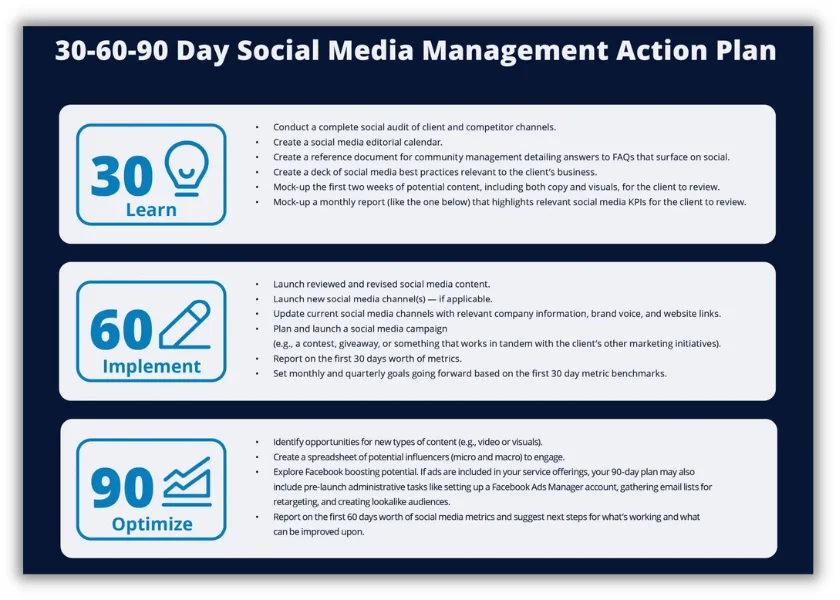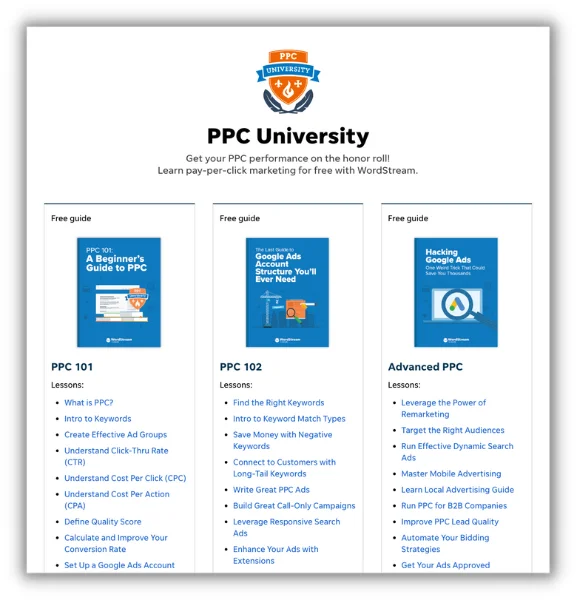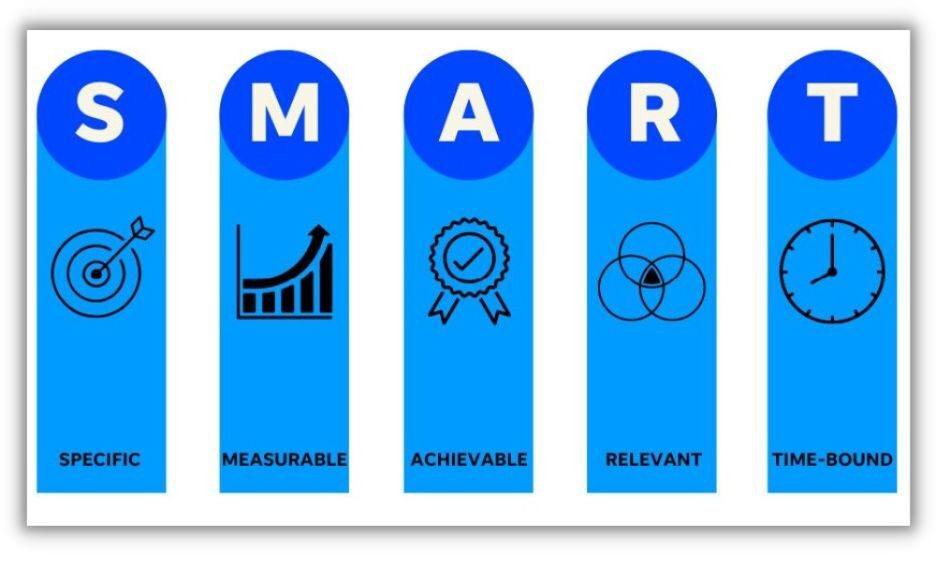PPC
How to Write a 30/60/90-Day Plan (Guide + Free Template!)

There’s “winging it,” and then there’s “cluelessly flailing about until you’re fired.” The former sounds cool, feels cool, and works a lot of the time. But, without any kind of foresight or planning, the latter can quickly become your reality.
Especially when you’re starting a new job. This is why it’s important to know how to write a 30/60/90-day plan.
Realistic expectations go a long way. When you’re a new employee, or even a manager onboarding a new employee, it’s easy to be overzealous. This can result in overpromising and underdelivering.
“By month two I can absolutely increase our leads by 200%.”
“By month two I expect you to increase our leads by 200%.”
No matter which end you’re on, manager or employee, these kinds of incorrect expectations set everyone up for failure. With a proper 30/60/90-day plan, you can create realistic goals, set yourself up for success, and safely “wing it” without all the flailing.
Table of contents
What is a 30/60/90-day plan?
A 30/60/90-day plan is used by both employees and employers alike. Typically, a 30/60/90-day plan outlines goals and expectations during the first 30, 60, and 90 days.
The idea behind a 30/60/90-day plan is to add structure to onboarding, with goals around learning the basics, meeting people critical to success, developing an actionable strategy, and eventually executing said strategy. You can also use a 30/60/90-day plan for new projects.

A 30/60/90-day plan should also include metrics for success. In other words, it’s important your goals are something you can measure with tangible metrics.
Things like:
- Complete X of Y tasks
- Finish X training modules
- Develop a strategy for Q3 with X deliverables
- Pitch X ideas for Y
While the best 30/60/90-day plans are the ones you can stick to, it’s worth pointing out that a plan can change. If you realize a few weeks in that some of the goals aren’t realistic, revisit your plan, tweak the goals or timelines, and ensure everyone else is on the same page.
How to write a 30/60/90-day plan for an interview
While not definite, some companies will mention a 30/60/90-day plan during the later stages of an interview. Some may bring up a 30/60/90-day plan ahead of an interview and ask you to prepare one, while others might have you lightly touch on a plan right then and there.
It’s unlikely you need a fleshed-out plan for an interview unless explicitly asked for ahead of time, but it doesn’t hurt to have some of the higher-level points covered. Before putting the plan together:
Carefully review the job description and the company itself
Look at the company’s mission statement, what they call out on their homepage, what they emphasize on the job description, etc. Think about what bigger role the position you’re applying for plays in the company and them reaching their goals.
For example, the Warby Parker About page serves as a great distillation of their mission: to inspire and impact the world with vision, purpose, and style.

Think about what goals matter to this position
What might their KPIs be? Metrics of success? Given the company’s size and audience, what types of metrics and goals make sense?
For example: You wouldn’t want to say you can drive 500 leads in 90 days via your marketing role if their audience is smaller and a good quarter is more like 5 qualified leads.
Bonus: Before the later stages of an interview, ask about the metrics of success for the position. Not only is this a great way to see if the role sounds realistic and aligns with your expectations, but it’s also great for informing your 30/60/90-day plan.
Be realistic and don’t oversell yourself
What can you feasibly do in 30/60/90 days? Keep in mind you’re new this entire time, so you’re also busy learning about the company, audience, and product or services.
When mapping out realistic goals, don’t neglect time spent on meeting people as well. You’re going to do a lot of meet and greets in your early weeks, and possibly some interviewing or shadowing.
Emphasize the role of learning and training
Pay attention to learning, training, and shadowing in your proposed plan. If you’re mapping out specific goals, write down the titles of potential stakeholders you’d want to partner with for these goals.
Learning is an essential part of any job and it shows you’re excited to grow. It’s also a great way to meet your team and those outside your own department as well.
For example, if your role involves Google Ads and you’re not very experienced, call out some Google Ads courses you’d take right out of the gate.

Even if a 30/60/90-day plan isn’t asked for during your interview, having a rough idea of one ready to go on a moment’s notice can’t hurt. If you’re really excited about one you put together, you could even mention sending it to the interviewer after your call’s concluded.
How to write a 30/60/90-day plan for a new job
The 30/60/90-day plan for a new job is similar to that of an interview, only you have the luxury of in-house resources and actually knowing (to some extent) what it is you signed up for. And even if you’re not asked to create one, it’s a good idea to make one yourself to stay on track.
Days 1-30: Learning, learning, learning
Typically, the first 30 days of a 30/60/90-day plan are all about learning. You’re new to the company and the role. You need to establish a foundational knowledge of the company, products, audience(s), and of course, your responsibilities.
- Base your goals around learning and growing in your role
- Who will you interview?
- What training will you need?
- Any courses you’d like access to?
- Certifications?
- Additional resources you’d like?
As you embark on your first 30 days, take note of questions you have the moment they arise and follow up on them. This is your chance to learn all you can, and filling in any knowledge gaps as early as possible can save you a ton of confusion down the road.
Also, as you map out goals for your first 30 days and beyond, make sure they’re concrete, measurable ones. Both you and your prospective manager should be able to ask and answer the question, “Is this goal complete?”

Make sure the goals you outline in your 30/60/90-day plan are SMART goals.
For example, you could state that by day 60 you want to complete X courses on Y topic, or have published four blogs and interviewed two in-house experts.
Days 31-60: Strategy and further learning
During your first 30 days, you’ve hopefully learned what you need to know to start thinking about strategy and upcoming tasks. So, your next 30 days should focus on strategy and further learning. Yes, more learning.
Get a feel for what people and the department need to succeed
- How can you help your department and company reach their goals?
- In order of quickest wins/impact, what tasks make the most sense?
- What support do you need to make these tasks happen?
Set realistic targets you can hit during this period
- What kind of projects can you start working on?
- What kind of progress can you expect to make on any projects?
Keep in mind you’re still learning at this stage, so you won’t be running at 100% speed in most cases.

Map out additional training, resources, certifications, etc.
You can’t cram all your learning into the first 30 days, so you’ll likely have more to do in the second 30 (and maybe the final, too).
- Think about what kind of knowledge gaps you might have at this stage, based on the job description, the department goals, and so on.
- If you can’t nail down a few concrete topics or knowledge gaps, put in some generic filler space to remind yourself that you’ll likely have more training to do as those 30 days get closer.
Days 61-90: Putting it all into motion
You’ve learned, interviewed, learned some more, strategized, and continued learning, so now it’s time to execute.
Map out every project, campaign, strategy, etc. that you plan on rolling out at this stage
- What will you need to make these executions go smoothly?
- Who needs to be involved? Who are the stakeholders?
- What could go wrong here and how can you plan for it?
- What kind of support do you need for these things to happen?
Plan to present your work thus far
- What kind of reporting needs to be in place ahead of time?
- What are the main KPIs or metrics of success for your projects or initiatives?
In general, think about how you’ll present your work to your leads and show the impact and progress you’ve made.

Set aside some time to review how things went
What good is all this action if you don’t stop to reflect?
While not something you can always plan ahead for in 100% detail, think about how you might go about revisiting your first 90 days, filling in any knowledge gaps, learning from mistakes, and ensuring your next 90 days are even better.
Simplifying life with a free 30/60/90-day plan template
A 30/60/90-day plan should make your time smoother and easier while guiding you to success. There’s no need to overcomplicate things, so keep it simple with our free template.

Get your copy of the template here.
Seeing success beyond 30, 60, and 90 days
Progress doesn’t stop at 90 days. You’re only just getting started. When you’ve completed your first 90 days, don’t hesitate to start another 30/60/90 that keeps the ball rolling in the right direction.
Before you know it, you’ll struggle to believe you were ever the naive newbie from those first 30 or 60 days!


















